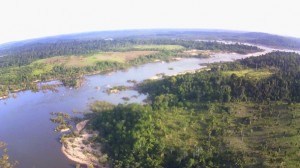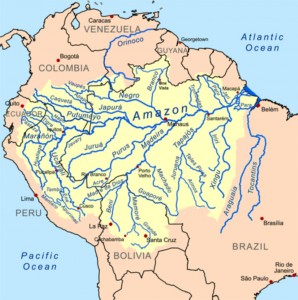From an Article by Georgina Gustin, Inside Climate News, March 25, 2021
Vast forests across Latin America and the Caribbean that are critical for storing carbon and conserving biodiversity are under increasing assault from logging, mining and ranching. But the best defense to this deforestation lies with the people who have lived in the forests for hundreds or even thousands of years, a newly-released report from the United Nations says.
The report reviewed roughly 300 studies that have looked at the role indigenous and tribal peoples have played as guardians of forest ecosystems in Latin America. These forested, richly biodiverse areas cover more than 400 million hectares—an area larger than Germany and France combined—and have a huge capacity to store carbon. About two-thirds of the area is in the Brazilian Amazon.
“There’s less deforestation and less harm to biodiversity in areas protected by indigenous people,” said Myrna Cunningham Kain, president of the Fund for the Development of the Indigenous Peoples of Latin America and the Caribbean (FILAC), who contributed to the report. “We’re providing evidence of what indigenous people have been saying for centuries.”
In recent years, a growing body of research has shown that forests occupied and managed by indigenous peoples are less prone to development or degradation than if they’re privately or government owned, largely because indigenous people have a different relationship to them. Their management of the land is important, the authors said, because the potential for carbon storage in tropical forests is immense.
“It turns out that we’re talking about 14 percent of all the carbon in the forests of the tropics,” said David Kaimowitz, the report’s lead author and a manager with the UN’s Food and Agriculture Organization (FAO). “That’s enough carbon to have big impacts. This is significant for the climate.”
This is the first time the UN has conducted a review of this research.
Critics of the findings have said there are obvious reasons that indigenously managed forests are less prone to deforestation—that they’re often very remote, sparsely populated and less fertile, so less desirable for agriculture. But Kamowitz said that does not explain everything.
“It’s not just that they’re more distanced or remote, or that they have less fertile soil. It’s not just that they have fewer people,” he said. “All of those things are true. But even when you account for all of those things, they’re still being deforested much, much less than other forests in Latin America, and the main reasons are culture and traditional knowledge.”
The new report comes at a crucial moment, when world leaders will tackle climate change at a series of upcoming summits.
President Joe Biden will convene a climate summit in April, the UN will host a biodiversity summit in May and two summits on food systems, in July and September. In November, climate leaders will meet for COP26 — the next UN conference of the parties on climate — in Scotland.
“These next six months are going to be key in terms of what the international community decides and how much it’s going to invest and what it’s going to invest in,” Kaimowitz said. “What we’re saying here is these communities and their forests should be a very high priority.”
Some governments in Latin America have been progressive in granting indigenous people land rights, which gives them greater negotiating power and control. But those rights are increasingly being undermined or challenged.
“They’re under threat in part because global commodity pressure has increased dramatically. More companies, more speculators, more ranchers, more drug dealers. They want to get into these areas and take these resources,” Kaimowitz said. “And in some countries, governments are more open to these forests being converted to other uses.”
A recent study, conducted by researchers with the Forest Peoples Programme, Yale Law School and Middlesex University, London, found that the governments of Brazil, Colombia, the Democratic Republic of the Congo, Indonesia and Peru — countries with enormous tracts of tropical forest — introduced new policies in 2020 dismantling protections for tribal communities. Governments have pushed these reversals as economic recovery measures in response to Covid-19.
While the review was not done in response to Covid-19, it comes as the protection of biodiversity has emerged as an urgent global priority, given its relationship with outbreaks of disease.
New research, also released this week, found that recent increases in zoonotic, vector-borne diseases were directly linked to deforestation, mostly in tropical countries, and were associated with the expansion of palm oil plantations.
The authors of the U.N. report referenced research from 2020 that found that many new diseases that have become epidemic in recent decades are connected to deforestation and forest degradation.
“There is no doubt that the Covid situation has made this more urgent,” Kaimowitz said. “Opening up intact forests and increasing the levels of interactions between intact forest and the outside world is an invitation for vector-borne and zoonotic diseases.”
But climate change is equally urgent, and simple policy changes that protect indigenous land ownership are an expedient way to address the crisis, the authors said.
“People look at the forests only as a place where you can get timber, but they don’t see the forest from the eyes of the indigenous people,” Cunningham Kain said. “For indigenous people it’s a spiritual space. It provides food and medicine. It’s a place where you build relationships, not only among people, but with the river, the water, with different species. What we expect from a report like this is that people begin to look at forests in a different way.”
>>>>>>>>>>……….>>>>>>>>>>……….>>>>>>>>>>
See also: Living on Earth: Belo Monte Dam Disrupts Amazon Floodplain Balance, Living on Earth, March 26, 2021

Drone photo of low water in the Volta Grande after North Energy's Hydrogram B cut 85% of the Xingu River’s flow into the Volta Grande
In a bid to boost electricity production, the operator of the Belo Monte dam on the Xingu River in the eastern Amazon rainforest is drastically reducing river flows for at least a year. Scientists say this will disrupt flood-dependent ecosystems as well as the indigenous communities in the area. Reporter Tiffany Higgins covered this for the news site Mongabay and joins Host Bobby Bascomb to discuss.

